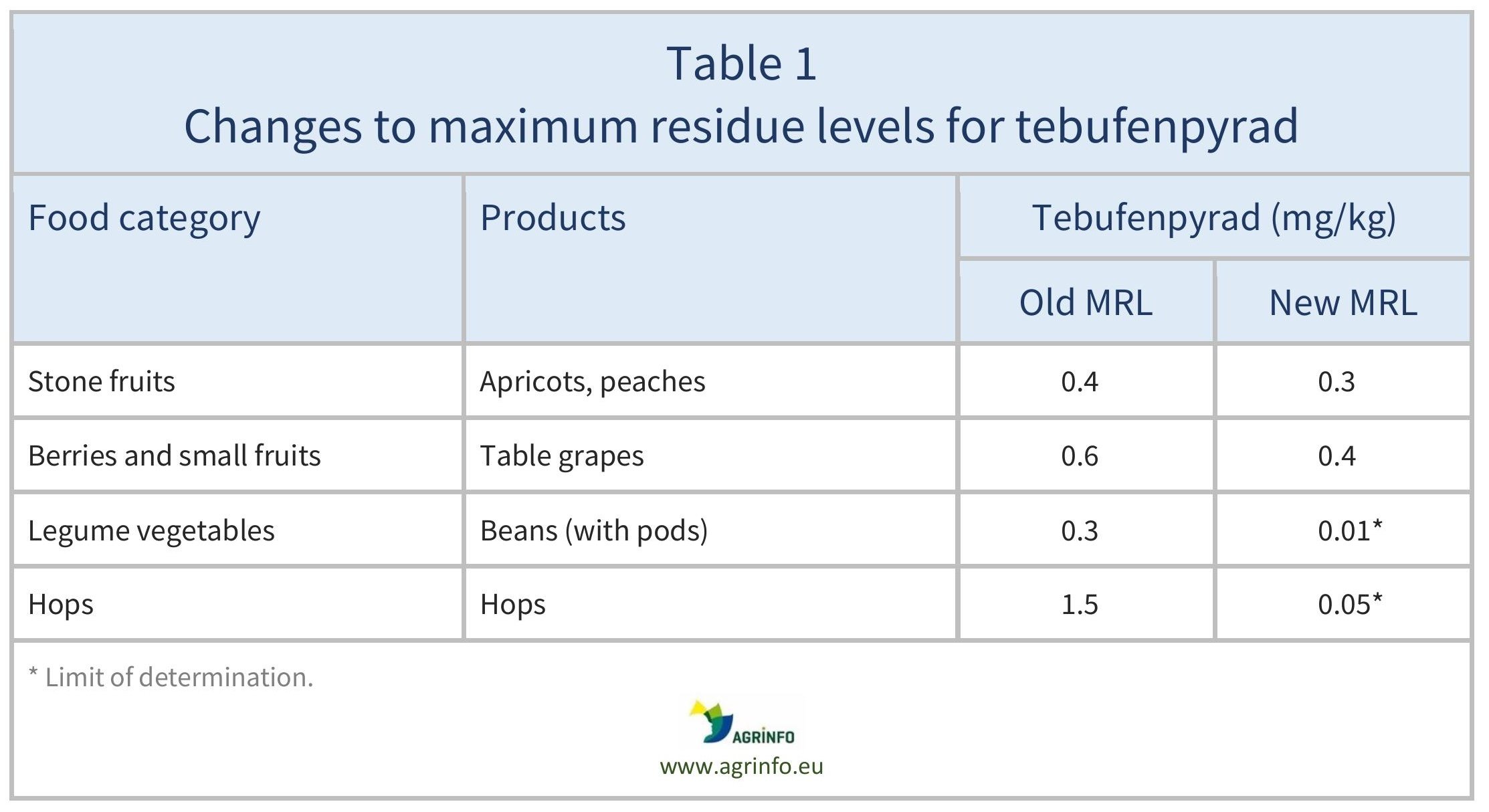Maximum residue levels for tebufenpyrad
- Food safety
- Pesticide MRLs
Summary
The EU has decided to lower the maximum residue levels (MRLs) for tebufenpyrad on some products. Where data in support of proposed MRLs is not available, the MRLs are reduced to the limit of determination (LOD, the lowest level that can be detected using the most modern and reliable analytical methods). The most significant potential impacts are on exports of beans and hops.
EU amends tebufenpyrad MRLs, with impacts on apricots, peaches, table grapes, beans, and hops
Commission Regulation (EU) 2024/2609 of 7 October 2024 amending Annex II to Regulation (EC) No 396/2005 of the European Parliament and of the Council as regards maximum residue levels for napropamide, pyridaben and tebufenpyrad in or on certain products
Update
The EU has decided to lower the maximum residue levels (MRLs) for tebufenpyrad on some products. Where data in support of proposed MRLs is not available, the MRLs are reduced to the limit of determination (LOD, the lowest level that can be detected using the most modern and reliable analytical methods). The most significant potential impacts are on exports of beans and hops.
Impacted Products
Apricots, peaches, table grapes, beans (with pods), hops
What is changing?
The EU has amended the MRLs for tebufenpyrad as summarised in Table 1.
Why?
The European Food Safety Authority (EFSA) reviewed the MRLs for tebufenpyrad, and found gaps in the data needed to support safe MRLs for certain products. After the applicant provided additional information to address these gaps, some MRLs were maintained. For apricot and peaches, the available data supported the establishment of a lower MRL.
However, for table grapes, beans (with pods), and hops, the additional information was insufficient. For those cases, EFSA (2023) recommended lowering the MRLs to the LOD.
Timeline
The new MRLs apply from 28 April 2025.
Except for table grapes, products exported before 28 April 2025 that comply with the old MRLs will not be removed from the EU market after April 2025, even if they do not comply with the new MRLs. The new MRL will apply to all table grapes placed on the EU market, even if exported before 28 April 2025.
Recommended Actions
Exporters of beans (with pods) and hops should review their current use of tebufenpyrad and evaluate possible alternative solutions in anticipation of MRL changes.
Exporters of apricots, peaches, and table grapes should assess whether their current agricultural practices can comply with the new MRLs.
Background
MRLs are set in accordance with the rules set out in Regulation 396/2005. For information on current MRLs for other substances, please consult the EU Pesticide Residues database.
Resources
EFSA (2023) Evaluation of confirmatory data following the Article 12 MRL review for tebufenpyrad. EFSA Journal, 21(2): 7774.
Sources
Commission Regulation (EU) 2024/2609 as regards maximum residue levels for napropamide, pyridaben and tebufenpyrad in or on certain products
Tables & Figures

Source: based on Regulation (EU) 2024/2609
Disclaimer: Under no circumstances shall COLEAD be liable for any loss, damage, liability or expense incurred or suffered that is claimed to have resulted from the use of information available on this website or any link to external sites. The use of the website is at the user’s sole risk and responsibility. This information platform was created and maintained with the financial support of the European Union. Its contents do not, however, reflect the views of the European Union.
EU amends tebufenpyrad MRLs, with impacts on apricots, peaches, table grapes, beans, and hops
Commission Regulation (EU) 2024/2609 as regards maximum residue levels for napropamide, pyridaben and tebufenpyrad in or on certain products
What is changing and why?
The EU has decided to lower the maximum residue levels (MRLs) for tebufenpyrad in apricots, peaches, and table grapes as summarised in Table 1. For beans (with pods) and hops, the MRLs are lowered to the limit of determination (LOD, the lowest level that can be detected using the most modern and reliable analytical methods). This is due to insufficient data to support the MRLs of these products.
Actions
Exporters of beans (with pods) and hops should review their current use of tebufenpyrad and evaluate possible alternative solutions in anticipation of MRL changes.
Exporters of apricots, peaches, and table grapes should assess whether their current agricultural practices can comply with the proposed reduced MRLs.
Timeline
The new MRLs apply from 28 April 2025.
Except for table grapes, products exported before 28 April 2025 that comply with the old MRLs will not be removed from the EU market after April 2025, even if they do not comply with the new MRLs.
Tables & Figures

Source: based on Regulation (EU) 2024/2609
Disclaimer: Under no circumstances shall COLEAD be liable for any loss, damage, liability or expense incurred or suffered that is claimed to have resulted from the use of information available on this website or any link to external sites. The use of the website is at the user’s sole risk and responsibility. This information platform was created and maintained with the financial support of the European Union. Its contents do not, however, reflect the views of the European Union.
